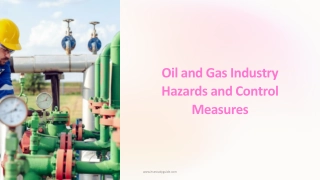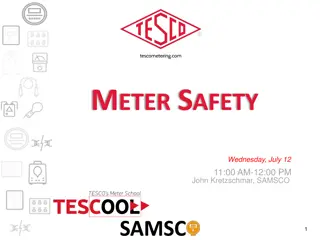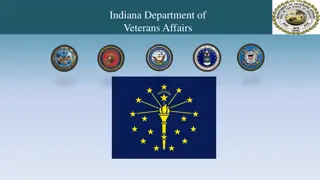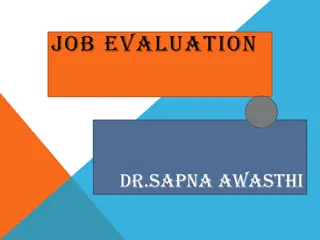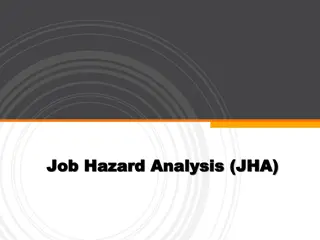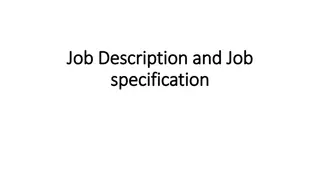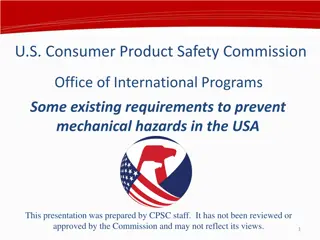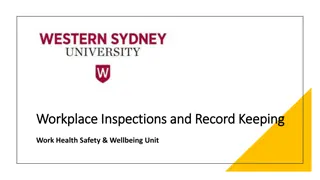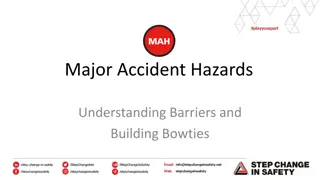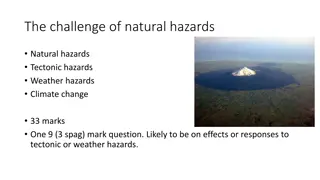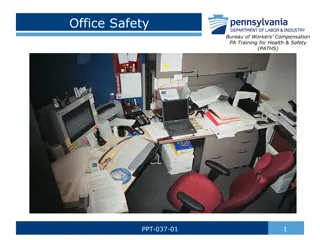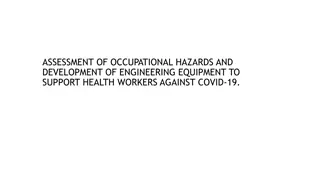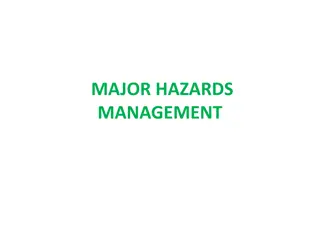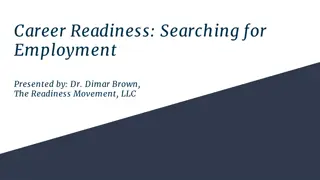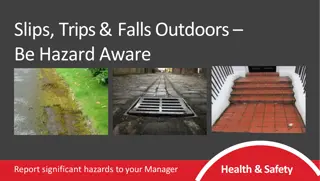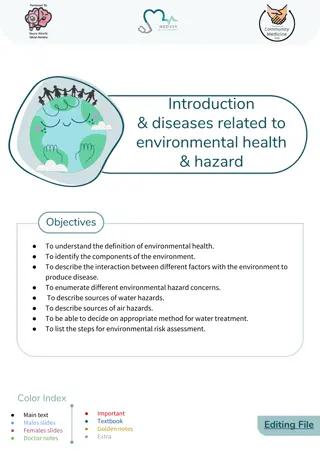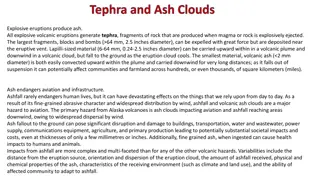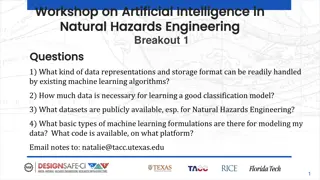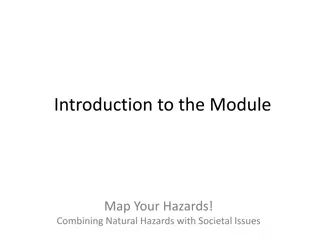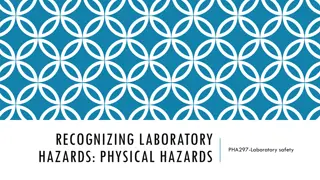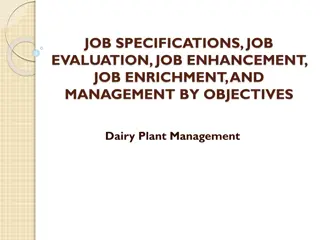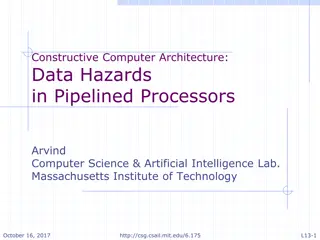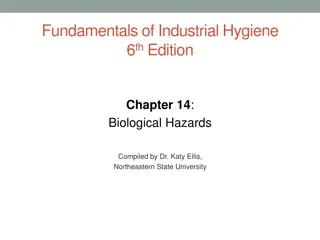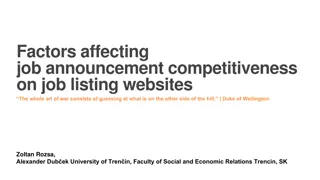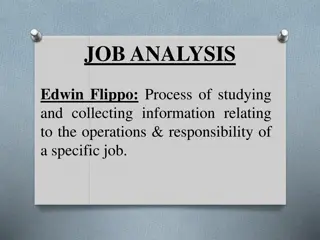Oil and Gas Industry Hazards and Control Measures
Learn to mitigate fire, explosion, exposure, physical hazards, falls, transportation risks, and natural hazards in the oil and gas sector. Effective control measures reduce risks and ensure worker safety. Explore key safety protocols.
2 views • 13 slides
Ensuring Mine Road Safety: Key Controls and Hazards
National Mine Safety Week 2023 focuses on safe road conditions in mining areas. The environment poses risks like overhanging trees and weather conditions, while road-related hazards include heavy loads and road design issues. This article highlights driving hazards, road design and maintenance hazar
0 views • 9 slides
Workplace Hazards and Safety Measures Awareness
Learn about common workplace hazards such as falls, chemical exposure, fire, electrical hazards, and repetitive motion injuries. Understand the risks associated with these hazards and the importance of prioritizing safety in the workplace to prevent accidents and injuries. Stay informed and take pro
1 views • 33 slides
Biological Hazards in the Hospital Community
Healthcare workers face various occupational hazards, including biological risks, in hospital settings. This article by Ephraim E. Ibadin explores the definition, types, risk factors, sources, prevention, and control of biological hazards in hospitals, emphasizing the importance of protecting worker
0 views • 30 slides
Environmental Hazards Faced by Veterans and Agent Orange Exposure Locations
Veterans may have been exposed to a variety of environmental hazards during their military service, including Agent Orange-related diseases, Gulf War illnesses, radiation-related diseases, traumatic brain injury, and more. Agent Orange exposure locations include Vietnam, C-123 airplanes, Blue Water
1 views • 40 slides
Understanding Job Analysis and Design Terminologies
Job analysis involves analyzing tasks, duties, and responsibilities to achieve organizational goals. It includes defining job terminologies like job, duty, task, position, and job title. Reflect on the numbers of jobs and work positions in a department setting. Know when and who performs job analysi
0 views • 31 slides
Essential Crane Safety Training and Hazards Awareness
This training covers various hazards associated with crane use, OSHA standards, inspection guidelines, and common issues like electrical hazards, overloading, and poor weight distribution. The content emphasizes the importance of maintaining crane safety to prevent accidents, injuries, and damage to
0 views • 30 slides
Understanding Job Evaluation: Process and Importance
Job evaluation involves systematically analyzing and assessing the relative worth of different jobs within an organization. It helps determine job hierarchy, fair wages, and minimize discrimination. The process includes gathering job-related data, comparing job duties, and ensuring equitable pay bas
0 views • 17 slides
Rigging Safety and Hazards Awareness
Learn about common rigging hazards, including fall hazards, struck-by and crushing hazards, electrical hazards, and rigging failure examples. Understand the importance of proper training, equipment inspection, and safety protocols to prevent accidents and injuries in rigging operations.
0 views • 34 slides
Importance of Job Hazard Analysis (JHA) in Workplace Safety
Job Hazard Analysis (JHA) is a crucial technique that focuses on identifying and mitigating hazards in work environments to prevent injuries, illnesses, and property damage. This analysis involves breaking down job tasks, identifying potential hazards, implementing controls, and providing necessary
0 views • 13 slides
Mastering Job Campaigns for Successful Employment
Discover the ins and outs of launching an effective employment campaign, from understanding the nature of job campaigns to exploring the history of job-hunting methods. Learn about important aspects like employer perspectives, job-hunting myths, and the significance of an active approach in job camp
0 views • 21 slides
Importance of Job Description and Job Specification in Job Analysis
Job description and job specification are essential components of job analysis, providing crucial data for HR managers to understand job requirements and find the right candidate. While not legal requirements, they play a vital role in recruiting, selecting, and placing employees effectively. Job de
0 views • 6 slides
Preventing Mechanical Hazards in Consumer Products: U.S. Regulations
The U.S. Consumer Product Safety Commission (CPSC) enforces various requirements to prevent mechanical hazards in consumer products. These regulations cover toys, children's clothing, infant products, and more. Standards such as ASTM F963 outline specific safety measures for small parts, strangulati
1 views • 13 slides
Importance of Workplace Inspections and Hazard Identification
Workplace inspections are critical processes to identify and mitigate hazards in a work environment. These inspections help ensure the safety of employees by addressing potential risks such as biological, chemical, physical, safety, ergonomic, and psychosocial hazards. Regular inspections allow for
2 views • 12 slides
Understanding Major Accident Hazards and Bowtie Models
Gain insight into the barriers protecting against hazards and explore the bowtie model's impact on safety. Learn about layers of protection, threats, preventative and mitigative barriers using the example of a caged lion scenario. Discover how to build a bowtie diagram to identify hazards effectivel
0 views • 11 slides
Understanding Natural Hazards and Their Impacts
Natural hazards, including tectonic and weather-related events, pose significant risks to humans and property. The effects and responses to tectonic hazards vary based on wealth levels in different regions. Earthquakes and volcanic eruptions result from physical processes, with patterns observed alo
1 views • 15 slides
Understanding Natural Hazards and Their Impact on Society
Explore the world of natural hazards, their causes, examples, and the transition to natural disasters. Learn how human actions can influence the frequency and severity of hazards. Discover the interconnectedness between nature and society in dealing with these events.
0 views • 10 slides
Understanding Risk Assessments and Hazards in Everyday Life
Risk assessments involve evaluating potential hazards and assessing the likelihood and consequences of those hazards. In the context of crossing the road, different scenarios demonstrate varying levels of risk based on factors such as vehicle speed, pedestrian behavior, and road conditions. By under
0 views • 23 slides
Ensuring Office Safety: Hazards, Prevention, and Training
Today's offices are prone to various hazards that can lead to injuries and health issues. This presentation covers common office accidents, safety considerations, and preventive measures such as ergonomic practices, fall prevention, and emergency action plans. It emphasizes the importance of control
0 views • 44 slides
Occupational Hazards in Healthcare and Engineering Equipment Development for COVID-19 Protection
Corona Virus, or COVID-19, poses significant health hazards to individuals, especially healthcare workers. This article explores the spread of the virus, types of health hazards, and solutions for prevention. It emphasizes the critical need for developing engineering equipment to support and protect
0 views • 12 slides
Understanding Environmental Hazards and Management
Exploring major hazards management, geology perspectives, ecological concepts, natural environmental hazards, classes of natural hazards, and introduction to environmental hazards management. The content covers ecological levels, abiotic factors, biomes, environmental degradation, and more.
0 views • 10 slides
Understanding Workplace Safety Hazards: Physical, Chemical, and Biological Risks
Explore the three main types of workplace safety hazards - physical, chemical, and biological - with a focus on identifying potential risks and ensuring a safe work environment. Learn about common hazards such as repetitive motion, chemical exposure, and handling biological materials, essential for
0 views • 97 slides
The Job Search: Essential Tips for Finding Employment
Explore the key aspects of job searching in "Career Readiness: Searching for Employment" presented by Dr. Dimar Brown. Understand how to search for a job, analyze job descriptions, and apply effectively. Learn about the job force in the United States, unemployment statistics, and the intricacies of
0 views • 12 slides
Understanding Natural Hazards and Plate Boundaries
Learn about natural hazards such as volcanic eruptions, earthquakes, and storms that pose risks to human populations. Discover how factors like urbanization, poverty, climate change, and farming increase vulnerabilities to these hazards. Explore plate boundaries, crust types, and examples of geologi
0 views • 21 slides
Preventing Slips, Trips, and Falls: Hazard Awareness and Safety Guidelines
Be aware of hazards both indoors and outdoors to prevent slips, trips, and falls. Keep work areas clear, return equipment to designated places, and report hazards to managers promptly. Look ahead for hazards, avoid distractions while walking, and conduct dynamic risk assessments to ensure safety. Re
0 views • 4 slides
Understanding Environmental Health and Hazards
The field of environmental health focuses on preventing human injury and illness by evaluating and limiting exposure to hazardous agents in the air, water, and soil. Various environmental hazards such as water and air pollution, climate change, and occupational hazards pose significant risks to huma
0 views • 10 slides
Understanding Volcanic Hazards: Tephra, Ash Clouds, and Lava Flows
Explosive volcanic eruptions produce tephra, fragments of rock that can be carried by volcanic plumes, ash clouds, and lava flows. Tephra, including blocks, bombs, and lapilli, poses aviation hazards, infrastructure disruptions, and health risks. Ashfall can impact communities and agriculture over v
0 views • 4 slides
Understanding Volcanic Hazards: Session Overview by Dr. Patrick Asamoah Sakyi
This session by Dr. Patrick Asamoah Sakyi introduces students to the hazards associated with volcanoes, covering topics such as volcanic eruption components, primary and secondary effects of volcanic hazards, beneficial aspects of volcanism, and predicting volcanic eruptions. The session also includ
0 views • 35 slides
Understanding Processor Hazards and Pipeline Stalls
Explore processor hazards like load-use and data hazards, along with strategies to avoid stalls in the pipeline. Discover how to detect and handle hazards efficiently for optimal performance in computer architecture. Learn about forwarding conditions, datapath design, and the impact of hazards on in
0 views • 30 slides
Understanding the Hazards of Arc Flash Incidents by Littelfuse Startco
Littelfuse Startco highlights the dangers of arc flash incidents, emphasizing the costly and dangerous consequences such as fires, burns, injuries, and even fatalities. The case study of an electrician's severe burns serves as a stark reminder of the potential risks associated with electrical hazard
0 views • 24 slides
Combining Natural Hazards with Societal Issues: Unit 1 Hazard Map Template
Delve into Unit 1 of the Hazard Map Template, identifying and locating regions susceptible to hazards by choosing top hazards in the mapping area. Create hazard maps, combine shapes, and include a key and sources for a comprehensive view of potential hazards and vulnerabilities.
0 views • 13 slides
Understanding Pipeline Hazards in Computer Architecture
Pipeline hazards in computer architecture are classified into three categories: structural, data, and control hazards. Structural hazards occur due to conflicts in hardware resources, data hazards stem from dependencies between instructions, and control hazards arise from branching instructions. The
0 views • 42 slides
Workshop on Artificial Intelligence in Natural Hazards Engineering
This workshop focuses on exploring the integration of artificial intelligence and machine learning with natural hazards engineering, discussing data representations, classification models, combining ML with hazards simulations, and addressing classification problems in the field. Participants engage
0 views • 5 slides
Map Your Hazards Module Overview: Identifying Natural Hazards and Social Vulnerabilities
Explore the Map Your Hazards Module, a comprehensive program designed to help communities identify natural hazards, assess social vulnerabilities, and enhance preparedness. Through tasks like local risk mapping and social surveys, learn to mitigate risks and support communities in facing potential d
0 views • 17 slides
Recognizing Laboratory Hazards: Physical Hazards and Corrosive Chemicals
Laboratory hazards, particularly physical hazards and corrosive chemicals, pose risks to individuals working in laboratory settings. Corrosives, such as acids, bases, oxidizing agents, and gases, can cause significant harm to eyes and skin. Proper precautions and handling procedures are crucial to m
0 views • 16 slides
Essential Concepts in Job Design, Specifications, Evaluation, and Management
Understanding job design, specifications, evaluation, and management is crucial in organizational effectiveness. Job analysis, motion study, job description, and job specification play key roles in defining and evaluating roles within an organization. Job evaluation determines the relative worth of
0 views • 14 slides
Data Hazards in Pipelined Processors: Understanding and Mitigation
Explore the concept of data hazards in pipelined processors, focusing on read-after-write (RAW) hazards and their impact on pipeline performance. Learn strategies to mitigate data hazards, such as using a scoreboard to track instructions and stall the Fetch stage when necessary. Discover how adjusti
0 views • 23 slides
Understanding Biological Hazards in the Workplace: A Comprehensive Overview
This chapter delves into the realm of biological hazards in occupational settings, shedding light on the risks posed by microorganisms, arthropods, allergens, toxins, and more. It highlights the diverse range of biological agents that can lead to infections, allergies, toxic reactions, and even seri
0 views • 45 slides
Factors Affecting Job Announcement Competitiveness on Job Listing Websites
Factors influencing job announcement competitiveness on job listing websites are crucial for attracting potential candidates quickly. This study explores job seekers' processing of information and how it impacts job pursuit intentions. Theoretical backgrounds on Job Pursuit Intentions (JPI) and Empl
0 views • 15 slides
Understanding Job Analysis and Job Description
Job analysis, as defined by Edwin Flippo, is the process of studying and collecting information about the operations and responsibilities of a specific job. This crucial task involves various components such as creating a detailed job description outlining the job title, qualifications, and more. En
0 views • 14 slides
